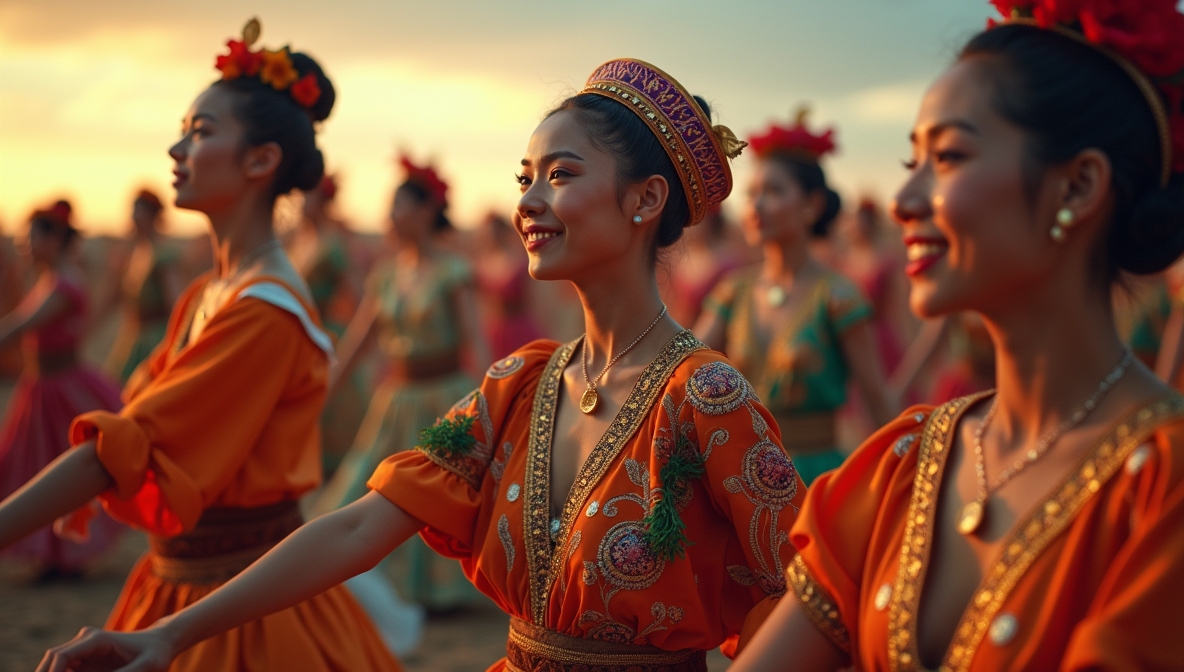Folk dances reflect the traditions, history, and cultural identity of a region. They tell stories, celebrate milestones, and bring communities together through movement and rhythm. These dances vary from energetic group performances to graceful solo routines, each shaped by local customs and influences.
1. Flamenco (Spain)
Flamenco is a passionate and intense dance originating from Andalusia. It combines percussive footwork, expressive arm movements, and intricate hand gestures. Dancers, known as “bailaores,” perform to the sound of Spanish guitar, hand claps, and deep, emotional singing. Costumes often include flowing dresses with ruffles for women and fitted jackets for men. The dance is a fusion of Romani, Moorish, and Spanish influences, making it one of the most recognizable cultural expressions of Spain.
2. Irish Step Dance (Ireland)
This traditional Irish dance is known for its rapid leg movements while maintaining a stiff upper body. It is performed both solo and in groups, with dancers wearing either soft or hard shoes, depending on the routine. Popularized by performances like Riverdance, Irish step dance remains a vibrant part of Irish celebrations and competitions worldwide.
3. Kathak (India)
Kathak is a classical Indian dance form rooted in storytelling. Originally performed by traveling bards, it evolved into a sophisticated art form combining graceful hand gestures, rhythmic footwork, and facial expressions. Dancers use ankle bells, or “ghungroos,” to highlight intricate beats and patterns. Kathak performances often depict scenes from Hindu epics like the Mahabharata and Ramayana.
4. Hula (Hawaii, USA)
Hula tells stories through fluid movements, hand gestures, and chants. There are two main types: Hula Kahiko, which follows ancient traditions with chanting and percussion, and Hula ‘Auana, which incorporates modern influences with melodic instruments. The dance plays a central role in Hawaiian culture, preserving history and mythology through motion and music.
5. Cossack Dance (Ukraine)
The Cossack dance, or Hopak, is an energetic folk dance featuring acrobatic jumps, deep squats, and rapid kicks. Originating from Ukrainian Cossacks, it was initially performed as a display of strength and agility after battle. Today, it is a dynamic showcase of national pride, often performed at festivals and celebrations.
6. Tarantella (Italy)
The Tarantella is a lively Italian folk dance characterized by fast, whirling movements. Traditionally associated with a ritualistic cure for tarantula bites, it later became a joyful dance performed at weddings and social gatherings. Dancers move in a rapid circle, often accompanied by tambourines and folk instruments.
7. Barynya (Russia)
Barynya is a fast-paced Russian dance featuring stomping, spinning, and energetic movements. Often performed in pairs or groups, it combines improvisation with structured steps. The dance reflects the festive spirit of rural communities, frequently appearing in folk festivals and stage performances.
8. Samba (Brazil)
Samba is deeply connected to Brazilian culture, especially during Carnival. The dance features rhythmic hip and foot movements, often performed to the beats of drums and other percussion instruments. Samba styles range from the fast-paced Samba no Pé, commonly seen in Rio’s Carnival, to the more structured Samba de Gafieira, which is danced in pairs.
9. Kecak (Bali, Indonesia)
Kecak is a unique Balinese dance performed by a large group of men chanting in rhythmic unison while sitting in concentric circles. It depicts scenes from the Ramayana, a Hindu epic, through intricate hand movements and dramatic storytelling. Fire and trance elements add to its mystical atmosphere, making it a striking visual and auditory experience.
10. Cumbia (Colombia)
Cumbia blends indigenous, African, and Spanish influences into a rhythmic and fluid dance. Traditionally performed with flowing skirts and light-footed steps, it represents Colombia’s multicultural heritage. The music features drums, flutes, and accordion, creating a hypnotic beat that guides the dancers.
11. Sirtaki (Greece)
Sirtaki, often associated with Greek celebrations, features slow, deliberate steps that gradually increase in speed. Inspired by traditional Greek dances, it gained popularity after being featured in the film Zorba the Greek. Dancers link arms and move in unison, creating a powerful sense of unity and rhythm.
12. Morris Dance (England)
Morris dance is a lively English folk tradition involving rhythmic stepping, sticks, handkerchiefs, and bells attached to the dancers’ legs. Groups, known as “sides,” perform intricate patterns while accompanied by folk music. This dance has medieval origins and is still performed during seasonal festivals.
13. Tamure (Tahiti, French Polynesia)
Tamure is a fast-paced Polynesian dance characterized by rapid hip movements and expressive storytelling. Traditionally performed by both men and women, it is accompanied by drumming and chanting. The movements are deeply connected to Polynesian mythology and cultural traditions.
14. Ghoomar (Rajasthan, India)
Ghoomar is a graceful Rajasthani dance performed by women wearing vibrant, flowing skirts. Dancers twirl in synchronized motions, creating mesmerizing patterns. Originally a royal dance, it remains a symbol of joy and festivity in Rajasthan.
15. Seungmu (Korea)
Seungmu is a Korean folk dance performed in Buddhist monasteries and festivals. The movements are slow and deliberate, symbolizing meditation and spiritual devotion. Dancers wear long flowing robes and wide sleeves, creating fluid, expressive motions that enhance the storytelling aspect of the performance.
16. Pericón (Argentina)
Pericón is a traditional Argentine dance featuring intricate group formations and synchronized movements. It has strong influences from Spanish and indigenous traditions, often performed during national celebrations. The dance is accompanied by guitars, accordions, and rhythmic hand claps.
17. Schuhplattler (Germany & Austria)
Schuhplattler is a Bavarian and Austrian dance where performers slap their thighs, knees, and feet while jumping and spinning. It originated as a courtship dance and remains a popular folk tradition at festivals and cultural events.
18. Hora (Romania & Israel)
Hora is a circular dance where participants hold hands and step in unison. In Romania, the Hora is a staple at weddings and celebrations, while in Israel, it became a symbol of national unity. The dance creates a sense of togetherness through its continuous, flowing motion.
19. Kolo (Serbia & Balkans)
Kolo is a traditional Balkan circle dance performed with linked hands and synchronized footwork. It varies in speed and complexity, with some versions featuring intricate steps and jumps. It is a key part of celebrations across Serbia, Croatia, and other Balkan regions.
20. Jota (Spain)
The Jota is a lively Spanish folk dance with rapid footwork and dramatic arm movements. It is performed in different regions of Spain, each with its variations. The music, featuring castanets and guitars, enhances the dynamic energy of the dance.
Final Word
Traditional folk dances carry the essence of a culture, preserving history through movement and rhythm. Each dance tells a unique story, keeping traditions alive for future generations.


